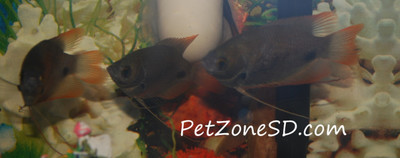Red Tail Giant Gourami
Posted by Max Gandara on on 17th Jul 2024
Red Tail Giant Gourami: The Majestic Titan of Freshwater Aquariums
The Red Tail Giant Gourami (Osphronemus laticlavius) is a truly impressive and stunning species that can become the centerpiece of any large freshwater aquarium. Known for their size, striking appearance, and intriguing behavior, these fish are a favorite among experienced aquarists. In this blog, we'll dive into the world of Red Tail Giant Gouramis, covering their origins, care requirements, behavior, and interesting facts.
What Are Red Tail Giant Gouramis?
Red Tail Giant Gouramis are native to the freshwater rivers and lakes of Southeast Asia, particularly in Borneo and Sumatra. They are members of the Osphronemidae family, which includes other well-known gourami species. These fish are renowned for their large size, vibrant coloration, and the distinctive red hue on their tail and fins, which gives them their common name.
Appearance
Red Tail Giant Gouramis are visually striking due to their impressive size and vibrant coloration:
- Size: These gouramis can grow up to 20 inches in length, making them one of the largest species of gourami.
- Coloration: Their body is typically a pale to dark gray, with a distinctive bright red or orange coloration on the tail and fins. Some individuals may also have a reddish hue on their scales, giving them a shimmering appearance.
- Body Shape: They have a laterally compressed body with a broad head and a slightly upturned mouth, which is typical of many gourami species.
Tank Requirements
Due to their large size and specific needs, Red Tail Giant Gouramis require a well-thought-out aquarium setup to thrive.
Tank Size and Setup
- Tank Size: A minimum tank size of 200 gallons is recommended for a single adult Red Tail Giant Gourami. Larger tanks are preferable, especially if you plan to keep multiple individuals or other large tank mates.
- Substrate and Decorations: Use a soft substrate like sand or fine gravel. Provide plenty of hiding spots and decorations such as large rocks, driftwood, and robust plants. Ensure that the tank has ample open swimming space due to the fish's size and activity level.
- Plants: While live plants can be included, choose hardy species that can withstand the gourami's potential for uprooting. Artificial plants can also be used for a similar effect without the risk of damage.
Water Conditions
- Temperature: Maintain a stable water temperature between 75-82°F.
- pH Level: Red Tail Giant Gouramis prefer slightly acidic to neutral water, with a pH range of 6.5-7.5.
- Hardness: They thrive in soft to moderately hard water, with a general hardness (GH) of 4-12 dGH.
Filtration and Maintenance
- Filtration: Use a powerful filtration system to keep the water clean and well-oxygenated. Red Tail Giant Gouramis produce a significant amount of waste, so efficient filtration and regular maintenance are crucial.
- Water Changes: Perform regular water changes (20-30% weekly) to maintain optimal water quality.
Diet
Red Tail Giant Gouramis are omnivorous and require a balanced diet to stay healthy and vibrant:
- Pellets: High-quality cichlid or gourami pellets should form the staple of their diet.
- Vegetables: Supplement their diet with blanched vegetables like spinach, zucchini, peas, and lettuce. These provide essential vitamins and fiber.
- Protein: Include protein-rich foods such as bloodworms, brine shrimp, and earthworms. Occasional feedings of small pieces of fish or shrimp can also be beneficial.
Behavior and Compatibility
Red Tail Giant Gouramis are generally peaceful but can become territorial, especially as they mature. They can be housed with other large, non-aggressive fish. Suitable tank mates include:
- Other large gouramis
- Large cichlids (non-aggressive species)
- Silver Dollars
- Large catfish
- Plecos
Avoid housing them with small or aggressive species that may be bullied or seen as food.
Breeding Red Tail Giant Gouramis
Breeding Red Tail Giant Gouramis in captivity can be challenging due to their size and specific requirements:
- Tank Setup: Provide a spacious breeding tank with plenty of hiding spots and floating plants for nest-building.
- Water Conditions: Maintain optimal water quality and stable parameters to encourage breeding behavior.
- Diet: Feed a nutritious and varied diet to ensure the health and vitality of the breeding pair.
If successful breeding occurs, the male will build a bubble nest and guard the eggs until they hatch. Provide suitable conditions for the fry to grow, including ample food and clean water.
Interesting Facts
- Longevity: With proper care, Red Tail Giant Gouramis can live for 20 years or more, making them a long-term commitment for any aquarist.
- Personality: These gouramis are known for their intelligent and interactive behavior. They can recognize their owners and may even come to the surface to greet them.
- Labyrinth Organ: Like other gouramis, Red Tail Giant Gouramis have a labyrinth organ that allows them to breathe air from the surface. This adaptation is useful in oxygen-poor waters.
Red Tail Giant Gouramis are magnificent and rewarding fish for experienced aquarists who can provide the space and care they need. Their impressive size, striking coloration, and engaging behavior make them a standout addition to any large freshwater aquarium. By ensuring the right environment, diet, and tank mates, you can enjoy the presence of these majestic fish for many years. Whether you're looking to add a single showpiece fish or create a dynamic community, the Red Tail Giant Gourami is sure to make a lasting impression.

